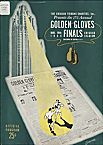Chicago was known for Al Capone St Valentines Day Massacre The Stockyards and the Great Chicago Fire. The cities reputation was not positive for racial equality that was not true with the sports business. Chicago included black players in ther pro basketball squad, supported the Harlem Globetrotters who were from Chicago not Harelm NY as they were promoted the windy city was home to the African Amerian women's basketball team The Roma's in the 1930's an industrial traveling team.
 Back in the late 1940s, team owner
Back in the late 1940s, team ownership would often schedule pro-college doubleheaders using local area schools in an effort to help fill seats.
(Photo and memorabilia courtesy of Bob Rosenberg)
The Chicago Stags were founded in 1946 and folded in 1950. Despite their short history, they were able to acquire the draft rights to a young Bob Cousy in a trade with the Tri-Cities Blackhawks (although he never played a game for them). When the Stags folded, a dispersal draft was held to divide up their players around the league. Bob Cousy was drafted by the Boston Celtics. Despite their short existence in the BAA and NBA, the Chicago Stags were rather successful in league play, making their way to the BAA finals in 1947 only to lose to the Philadelphia Warriors.

Built in the early 1920s, the Chicago Stadium was considered by many to be one of the finest and loudest indoor arenas in the United States.
(Photo and memorabilia courtesy of Bob Rosenberg)
Chicago also became the city where basketball took a big step toward crossing the “color line.” From 1939 to 1948, the World Professional Tournament was played in the city, where black and white teams would routinely face off, setting the stage for the Stags. In the 1948 preseason, the Stags invited six African-American players to try out; on October 9, 1948, The New York Age announced, “Color Line is Broken in Basketball Assn. of America: Six Join Chicago Stags”. The team was gone before the 1950 season.
 In their four year history (1946-50), the C
In their four year history (1946-50), the Chicago Stags made the playoffs each season and compiled an impressive 145-92 overall record (.612). The team’s best player was a 6’2” guard out of St. John’s, Max “The Touch” Zaslofsky (10).
(Courtesy of Bob Rosenberg)
Following agitation to end the ban, notably by theChicago Tribune, boxing was legalized in 1926, upon which the Illinois Boxing Commission was organized. In 1927, in the largest live boxing gate in history, 104,000 fans at Soldier Field watched Gene Tunney defeat Jack Dempsey in the famous “long-count” fight. The Chicago Stadium, opened in 1929, became an important boxing venue, hosting many major championship bouts.
 |
 |
In 1949, boxing promoter James Norris and Chicago Stadium owner Arthur Wirtz formed the International Boxing Club, which controlled pro boxing competition before being broken up by the federal government as a monopoly in 1957. During that time the Chicago Stadium played host to many of the biggest fights in the country, featuring such boxers as Sugar Ray Robinson, Rocky Marciano, and Floyd Patterson. In 1961, Wirtz ended boxing matches at the Stadium, and thereafter Chicago declined as a boxing town.
In 1949 the first million dollar boxing gate manager checks into the Lincoln Park North Hotel ,a 31 year old young man introduces himself to Kearns a mere 4 weeks later the man in
1949 DEMPSEY HOVLAND INRODUCES HIS PROFESSIONAL WOMEN'S BASKETBALL TEAM AT THE Chicago Stadium
DEMPSEY HOVLAND'S 1ST SQUAD-THE TEXAS COWGIRLS FROM CHICAGO
The team played exhibition games at the Mad House on Madison in 1949 hitting the road in 1950 as the premier top gate seller in women's barnstorm basketball for 28 years

No comments:
Post a Comment